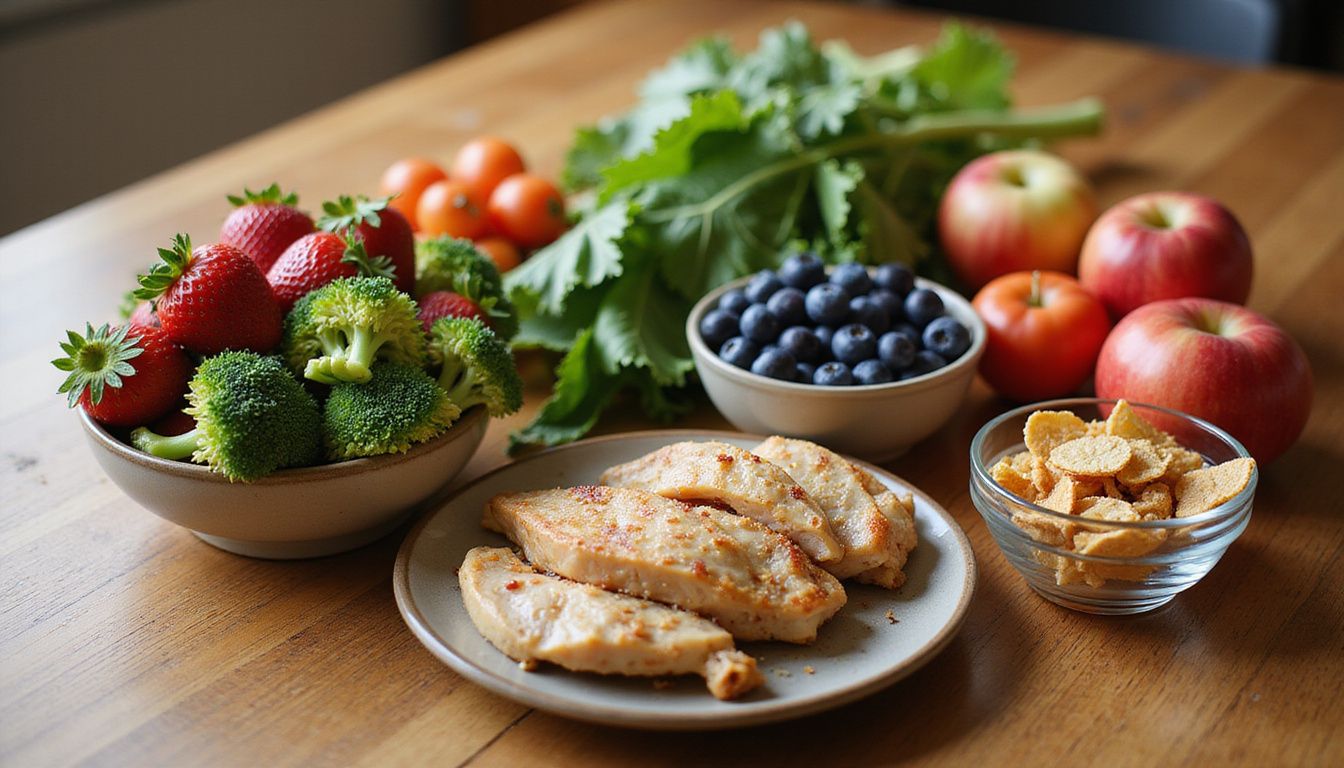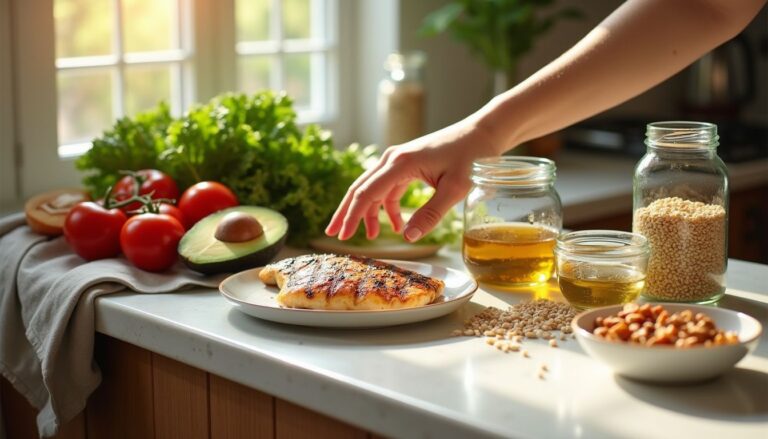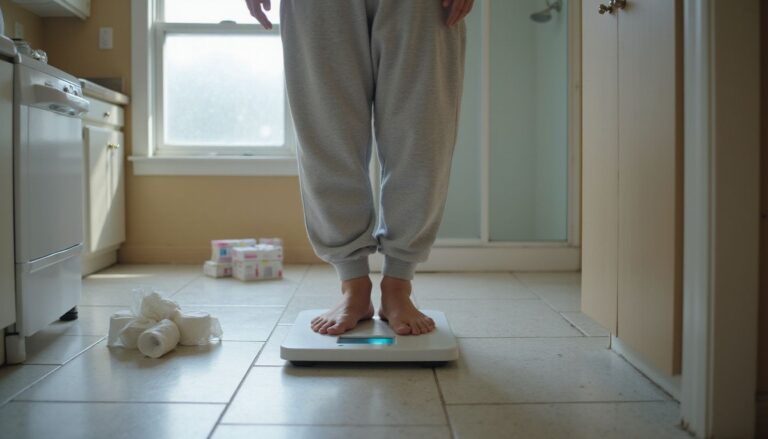7-Day Low Calorie Diet Plan: Meal Plan Menu For Effective Weight Loss
Our Nutrition Assistant AI Suite will transform your body. You will lose fat, get toned, and build muscle. Gain confidence and optimal health.
If losing weight feels confusing, a low-calorie meal plan brings order and support. Research shows a structured eating plan can help you lose weight and improve health when it includes solid nutrition.
In this guide, you get seven days of menus, serving ideas, and simple rules that strengthen healthy eating habits. Use the next sections to find what fits you best and start with confidence.
Key Takeaways
- A 7-day low-calorie diet plan often limits intake to 1,200 to 1,800 calories daily for adults. It may reduce risks linked to obesity.
- Losing 5% to 10% of your weight in six months can lower LDL cholesterol, blood pressure, and risks for heart disease or diabetes, based on CDC data.
- Meals focus on lean proteins, whole grains, vegetables, and high-fiber foods while limiting sugary snacks, fried foods, fatty meats, and sweetened drinks.
- Planning meals ahead with calorie-tracking apps such as MyFitnessPal supports portion control and improves your odds of following a structured menu.
- Balanced nutrition, combining protein with fiber-rich choices, helps prevent muscle loss during weight loss and keeps you full longer (Leidy HJ et al., AJCN 2015).
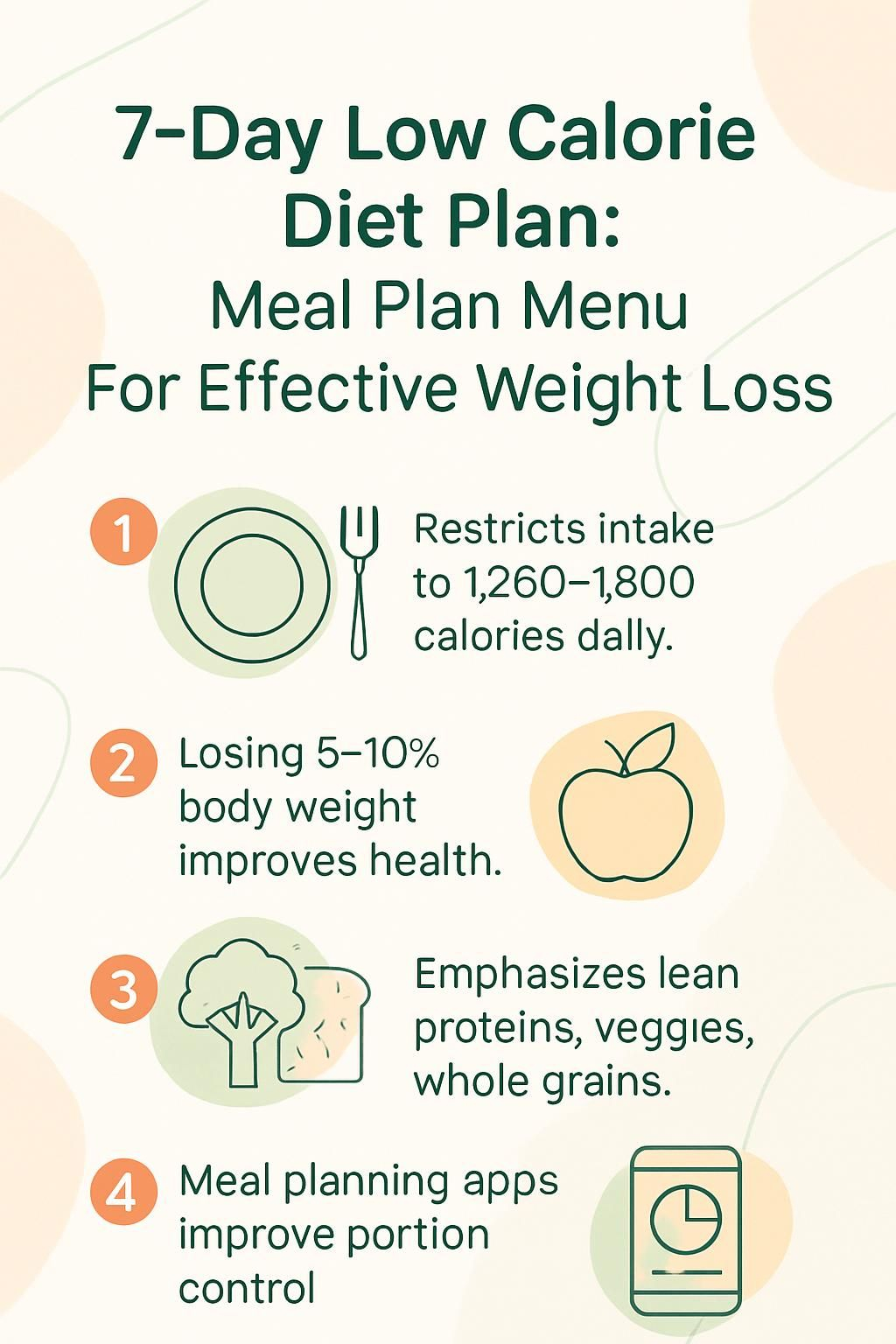
What is a Low-Calorie Diet?
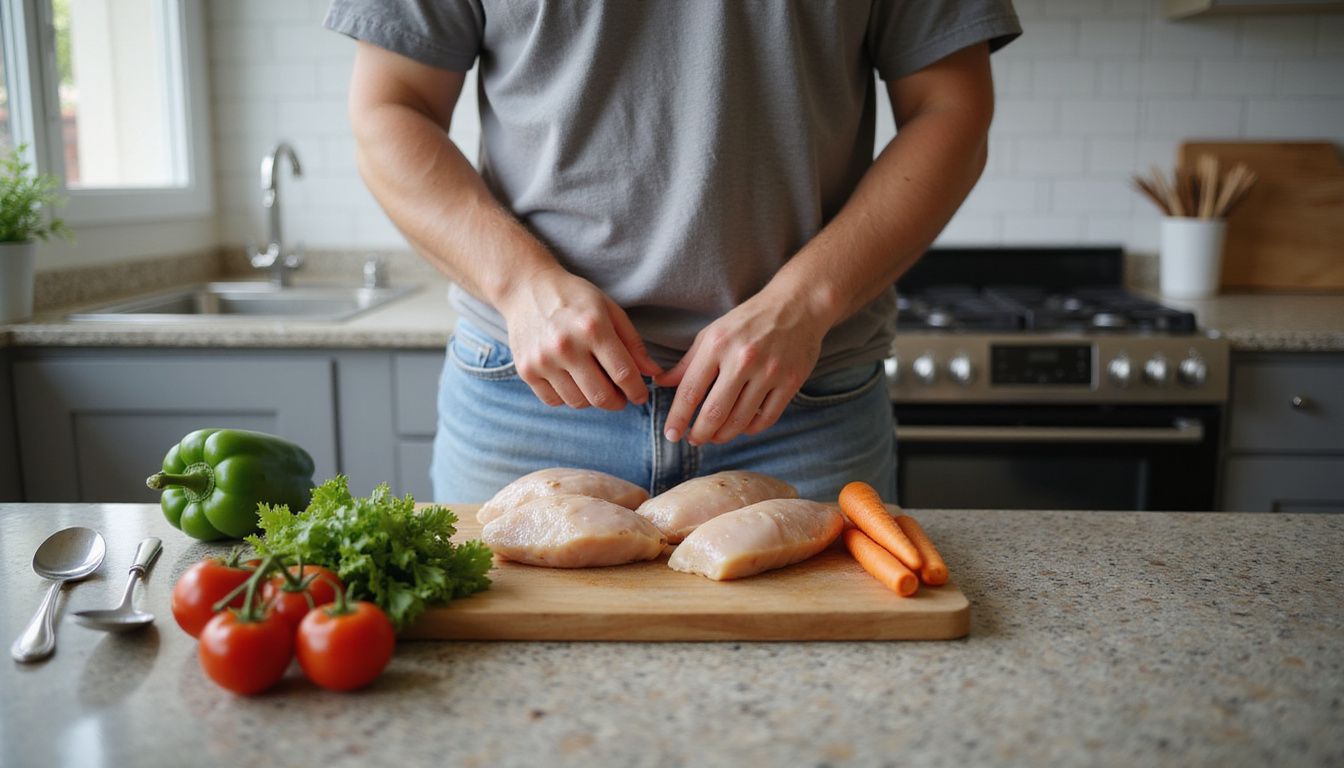
A low-calorie diet limits the number of calories you eat each day to support weight loss. Many dietitians favor this approach because it helps with healthy weight management and can lower risks tied to excess body fat.
What does a low-calorie diet mean and why is it used?
A low-calorie diet reduces daily energy intake to help with weight loss or to manage weight gain from certain conditions. In the United States, it is often called a weight-loss diet. Some plans provide about 1,200 calories per day, but the right level depends on your age, sex, activity, and health goals.
Clinicians may suggest this plan to help reduce obesity-related risks, including higher risk in some cancers. Dietitians apply peer-reviewed studies and the Dietary Guidelines for Americans to set calorie targets so you get enough nutrients while reducing total intake.
This strategy limits high-calorie items such as sweetened beverages and emphasizes whole grains, vegetables like broccoli and cauliflower, lean proteins such as poultry or turkey, cottage cheese, beans, nuts like almonds, and healthier oils in place of saturated fat.
During steroid treatment after breast cancer in 2023, I shifted to a lower-calorie menu that added more protein and fiber, such as brown rice with roasted vegetables. I noticed steadier energy and fewer cravings.
Choosing foods rich in fiber and protein keeps you full longer and helps control hunger during the day.
How does a low-calorie diet benefit weight loss and overall health?
Reducing calories helps your body tap stored fat for energy. Cutting about 500 calories per day may lead to around one pound of weight loss per week.
Losing just 3% to 5% of your body weight can improve triglycerides and blood glucose. Reaching 5% to 10% loss within six months is often linked to lower blood pressure, reduced LDL or bad cholesterol, and higher HDL or good cholesterol.
Keeping your body mass index, or BMI, in the 18.5 to 24.9 range lowers risk for heart disease, high blood pressure, type 2 diabetes, breathing problems, and some cancers.
Tracking meals can reveal helpful swaps. For example, lettuce wraps instead of mayonnaise-heavy sandwiches lower calories and add nutrients. Choosing baked fish instead of fried cuts down on unhealthy fats and supports heart health.
Limiting sugary snacks and salty processed foods reduces overeating. Fruits, nuts, and seeds add dietary fiber, which supports digestion and helps you feel full while following a traditional American cuisine style built on unprocessed foods.
Guidelines for a 7-Day Low-Calorie Diet Plan
Clear guidelines help you pick the best foods to support steady weight loss and better health. Use them to build a balanced plate that fits your calorie needs.
What is the recommended daily calorie intake?
Many adults aiming for healthy weight loss choose between 1,200 and 1,800 calories per day. A 1,200-calorie plan often includes plenty of vegetables, fruits, and lean protein at each meal.
Women often start around 1,200 to 1,400 calories. Men often begin at about 1,500 to 1,800. Use an online calculator or a BMI app to estimate needs based on your goals and body type. Talk with your healthcare provider before starting a very restrictive diet such as a 1,200-calorie menu.
Calorie needs vary from person to person due to age, activity, and health status. Some people do better with targets like 1,300 calories or a higher level if they need more energy for daily life.
Why is balanced nutrition important on a low-calorie diet?
Balanced nutrition helps you feel satisfied while you cut calories. Include lean protein such as roast beef or fat-free yogurt to protect muscle during weight loss.
Get fiber from produce like broccoli and berries to support digestion. Research shows that combining vegetables, fruits, whole grains, and protein leads to better weight results than cutting calories alone.
Planning a healthy diet that covers all essential nutrients helps prevent vitamin and mineral gaps during calorie restriction. The DASH diet, which limits sodium, is one example of a balanced approach that also supports heart health.
If you cut entire food groups or focus only on calories, you raise your risk of fatigue and other problems over time, according to sports nutrition experts.
Which foods should I include and avoid?
Choose nutrient-dense foods to support weight loss across this 7-day plan. Select low-fat or nonfat milks and yogurts, lactose-free choices, or plant-based milks for breakfast or snacks.
Load up on fresh, frozen, or low-sodium vegetables in meals like coleslaw or roasted sides. Fresh berries and fruit make satisfying snacks without added sugar.
Great staples include whole-wheat bread, brown rice, quinoa, air-popped popcorn, skinless poultry such as grilled chicken, lean cuts of beef or pork trimmed of fat, and fish prepared by baking or grilling. Beans, tofu, and tempeh offer plant protein. Keep nuts to about one ounce per serving. Limit nut butter to two tablespoons. Add seeds to salads or oatmeal.
Cook with olive oil, about one tablespoon, instead of vegetable shortening. Skip full-fat cheese and heavy cream since they add many calories from fat. Avoid battered and fried vegetables that drive calories up. Choose fruit packed in water or its own juice over syrup.
Pick water, sparkling water with citrus, unsweetened tea, or black coffee instead of sweetened juices that spike blood sugar. This matters if you are managing high blood pressure.
Using an online calculator helped me stay on track when I focused on leafy greens and lean protein and skipped high-calorie desserts after dinner.
Leave fatty meats like marbled steak off your list, and remove skin from poultry to limit saturated fat. Reduce processed items with added sugars, such as sweet jams and sugar-rich cereals. Use low-fat mayo sparingly, no more than two tablespoons, and keep higher-calorie spreads like whipped butter to one tablespoon per day if you include them at all.
How to Prepare for a 7-Day Low-Calorie Diet Plan
Preparation sets you up for success. Set realistic goals, stock smart staples, and use simple tools to track progress.
How do I set realistic weight loss goals?
Work with your healthcare provider to set safe targets. Many experts suggest losing 5% to 10% of your starting weight over about six months.
For example, if you weigh 200 pounds, a healthy goal is 10 to 20 pounds over that time. This supports better nutrition habits and steady progress.
Focus on weekly goals. Losing one to two pounds per week is effective and safer for long-term results. Plan meals, control portions, track calories with an app or food diary, and build a smart grocery list.
Following these steps, even for a single day early in the week, makes the plan feel manageable.
What are effective meal prepping and grocery shopping tips?
Plan your meals and snacks before you shop. Make a list that covers all ingredients and favors low-calorie options. Choose simple recipes that use baking, roasting, broiling, or grilling.
Prep ahead to save time on busy days. This reduces the pull of high-calorie convenience foods and lowers stress.
Buy fruits like berries and vegetables in bulk when they are fresh. Choose protein sources such as eggs, chicken breast, tofu, or legumes if you prefer vegetarian meals. Measure portions and use containers labeled with calories per serving. A digital food scale helps with accurate portions for grains, nuts, and other staples.
Which tools help track calories and portion sizes?
Use measuring cups and spoons for common foods like grains, nuts, and dressings. Guessing often leads to larger portions and extra calories.
Apps like MyFitnessPal and Lose It let you log meals by weight or serving size. Their databases include many produce items and packaged foods. You can track calories, protein, carbs, and more. Log snacks too, then spread them across the day to avoid big hunger swings.
Digital kitchen scales add precision if recipes list grams or ounces. Weighing ingredients gives extra control, especially when cooking from scratch.
These simple tools support healthy eating habits at every stage of your low-calorie routine.
Day 1: Sample Meal Plan
Day 1 sets a balanced tone. Keep meals simple, colorful, and satisfying.
What is a healthy breakfast option for Day 1?
Have 3/4 cup bran flakes with one sliced banana and a cup of fat-free milk. The bran adds fiber to help you stay full. The banana brings natural sweetness and potassium for muscle function. The milk provides protein and calcium with fewer calories.
This is a balanced start with carbs, protein, and fiber. It is quick, affordable, and easy to track.
What should I eat for lunch on Day 1?
Fill a mini whole wheat pita with 3 ounces sliced turkey, half a roasted pepper, one teaspoon mayonnaise, mustard, and crisp lettuce. Add one mozzarella string cheese for extra protein and enjoy two kiwis for dessert.
For a Mediterranean twist at about 290 calories, try a veggie niçoise mix with hummus inside the pita. Prepping ingredients the night before makes this lunch easy to grab and go.
What is a nutritious dinner idea for Day 1?
Enjoy 4 ounces flounder for lean protein under 200 calories. Serve with 1 cup cooked couscous and 1 cup broccoli for fiber and vitamins. Pick a single-serve ice cream for dessert to satisfy a sweet tooth while staying on track.
Pre-portioned treats can make it easier to honor your targets without feeling deprived.
Day 2: Sample Meal Plan
Day 2 keeps flavor high while calories stay moderate.
What is a good breakfast choice for Day 2?
Blend 1 cup frozen berries with half a banana and 8 ounces low or fat-free milk. This smoothie offers fiber, potassium, calcium, and a controlled calorie count. Add 1 or 2 hard-boiled eggs for protein that supports fullness.
This quick breakfast fits busy mornings and can reduce mid-morning cravings.
What lunch can I prepare on Day 2?
Start with 1 cup vegetable soup. Pair it with a veggie burger on whole grain toast for fiber and protein. Add 1 cup grapes for a fresh, sweet side with few calories.
Swap in a mushroom-quinoa burger if you want variety. Soup plus fruit often holds hunger in check until dinner.
What dinner fits a low-calorie plan on Day 2?
Choose BBQ cutlets for a lean, flavorful dinner at about 265 calories per serving. Add citrus slaw for crunch and vitamins or sautéed spinach for iron and fiber. Include a baked potato topped with salsa and Greek yogurt for hearty complex carbs with less fat.
Balancing lean protein with fiber-rich sides helps manage appetite into the evening.
Day 3: Sample Meal Plan
Day 3 blends comfort foods with smart portions.
What should I eat for breakfast on Day 3?
Cook 1/2 cup oats in low-fat or soy milk. Add half an apple in slices and drizzle 1 teaspoon honey. Sprinkle cinnamon for flavor without extra calories.
This mix of whole grains, fruit, and protein keeps energy steady through late morning. Let the oats sit for five minutes for a creamier texture.
What is a balanced lunch for Day 3?
Make chicken salad with 4 ounces cooked chicken breast for lean protein. Add 1/4 cup chopped red grapes, 1 tablespoon sliced almonds, and 1/4 cup diced celery for crunch and fiber. Mix with 1 tablespoon light mayo and 1 tablespoon plain Greek yogurt for a lighter dressing.
Serve over lettuce with one slice multigrain toast. This balance of protein, healthy fats, and whole grains often prevents afternoon slumps.
What dinner works well for Day 3?
Steam 4 ounces shrimp for lean protein. Add a baked potato topped with 3 tablespoons salsa and 1 tablespoon Greek yogurt. Include three cups fresh spinach, steamed or lightly sautéed with cooking spray.
Finish with one ounce chocolate or an ice cream bar between 100 and 150 calories. Pre-portioning shrimp and washing spinach ahead can make hectic nights easier.
Day 4: Sample Meal Plan
Day 4 is about simple prep and steady protein.
What breakfast is suitable for Day 4?
Eat 1 cup Greek yogurt with 1 cup berries. You get protein for fullness, plus calcium and probiotics for gut health. Berries add fiber, vitamin C, and antioxidants.
I use this breakfast often because it is fast and satisfying. Studies suggest higher-protein breakfasts can reduce hunger later in the day and support weight goals.[1]
What lunch options are recommended for Day 4?
Start with one cup tomato soup. Make a sandwich using one mini whole wheat pita filled with three ounces roast beef, one teaspoon horseradish, mustard, tomato slices, and lettuce. Add two cups raw vegetables and a quarter cup hummus for dipping.
This mix provides lean protein, whole grains, and plenty of fiber to carry you through the afternoon.
What dinner can I have on Day 4?
Poach 4 ounces salmon for omega-3 fats and lean protein. Make a simple coleslaw with 1 1/4 cups shredded mix, two sliced scallions, 1 tablespoon rice vinegar, and 1 1/2 teaspoons olive oil. Serve with 1 cup cooked quinoa for whole grains and extra fiber.
Light dressings keep flavor high and calories in check.
Day 5: Sample Meal Plan
Day 5 brings familiar favorites with smart swaps.
What is a healthy breakfast for Day 5?
Combine 1 cup Cheerios, 1/2 cup fresh berries, and 1 tablespoon slivered almonds. Add 6 ounces Greek yogurt for extra protein and creaminess. You get whole grains, vitamins, healthy fats, and about 18 grams of protein.
This kept me full during busy mornings. Switch berries based on season or add a pinch of cinnamon.
What lunch ideas fit Day 5?
Make mushroom quesadillas with a whole wheat tortilla, low-fat cheese, and sautéed mushrooms. Add cucumber spears for crunch and hydration with few calories. Include 1/2 cup cottage cheese or Greek yogurt for more protein and pack two clementines for dessert.
This combo is easy to prep ahead and helps avoid afternoon snacking.
What dinner should I prepare on Day 5?
Cook balsamic-glazed pork tenderloin at about 370 calories per serving. Roast butternut squash on the side for vitamins and fiber with modest calories. Brush the pork with a simple balsamic glaze before roasting or grilling.
High protein from pork and complex carbs from vegetables help you feel satisfied longer.
Day 6: Sample Meal Plan
Day 6 keeps mornings hearty and evenings full of flavor.
What breakfast works well on Day 6?
Top a whole grain waffle with 2 tablespoons nut butter and a small sliced banana. Sprinkle cinnamon or nutmeg for extra flavor without added sugar. Drink 8 ounces fat-free milk for about 90 calories and 8 grams of protein.
This mix of fiber, carbs, and protein supports fullness through the morning.
What lunch options are good for Day 6?
Make tuna salad with low-fat mayo and yogurt, about 135 calories per serving. Add ten baby carrots for volume and crunch. Include two-thirds cup Greek yogurt for extra protein and have a small pear for natural sweetness and vitamin C.
This lunch kept my energy steady until dinner.
What is a good dinner choice for Day 6?
Prepare spicy sausage jambalaya with turkey or chicken sausage to keep calories lower. It offers protein and complex carbs that help maintain muscle and control hunger. Pair with 3 cups sautéed spinach cooked with garlic and 1 tablespoon olive oil.
This comforting meal fits daily calorie limits and ends the day on a satisfying note.
Day 7: Sample Meal Plan
Day 7 wraps the week with simple meals that taste bright and fresh.
What should I eat for breakfast on Day 7?
Toast half an English muffin. Top with one ounce reduced-fat cheese, a slice of tomato, and one cup cooked spinach. Add a poached egg for protein and serve with a grapefruit for vitamin C.
This combo brings fiber, calcium, and steady energy without a heavy calorie load.
What lunch fits Day 7’s plan?
Make a black bean salad with 1/2 cup black beans and 1/2 cup chopped peppers and onions. Drizzle one teaspoon vinegar over the mix and serve on greens for added fiber. Add one corn tortilla for whole grains and a piece of fruit for extra vitamins.
Plant protein plus colorful produce keeps calories reasonable and hunger under control.
What dinner is recommended for Day 7?
Try lemon-herb baked cod, about 4 ounces, with 1 cup roasted baby potatoes and a large side salad. Dress the salad with 1 teaspoon olive oil and lemon juice. This dinner balances lean protein, complex carbs, and vegetables while staying calorie conscious.
It is an easy way to finish the week feeling satisfied and consistent.
Tips for Sticking to a Low-Calorie Diet
Small daily habits make the plan easier to follow and less stressful.
How can I avoid common pitfalls and cravings?
Drink calorie-free beverages like water, herbal tea, or black coffee. Build meals around protein-rich foods, high-fiber vegetables, and fruits with high water content. Choose carrot sticks, air-popped popcorn, or a handful of berries for simple snacks.
Plan and prep meals and snacks so busy days do not derail you. Mix some white grains with whole grains if taste is an issue. Add vegetables to omelets, sauces, and soups for volume without many calories. Stay engaged with errands, calls, or a short walk when cravings hit.
Why is staying hydrated and watching portion sizes important?
Hydration supports metabolism and helps control hunger cues. Many people mistake thirst for hunger, which can lead to overeating. Water or unsweetened tea between meals helps you stick to your plan.
Measure portions with cups or spoons to track calories accurately. Portion awareness supports steady weight loss and helps you meet daily targets.
How does exercise enhance weight loss results?
Exercise burns calories and protects muscle while you lose fat. The American Heart Association suggests at least 150 minutes of moderate exercise each week for heart health and weight control.
Activities like brisk walking or cycling can raise your metabolism after you finish. Exercise also helps regulate hunger hormones, which may reduce cravings and support your meal plan.
Pair consistent movement with balanced meals for the best long-term results.
Frequently Asked Questions
Find quick answers to common questions as you start your 7-day plan.
Is a 1,200-calorie diet right for everyone?
A 1,200-calorie plan is very restrictive and does not fit most adults. The Dietary Guidelines for Americans estimate that many women need 1,600 to 2,400 calories daily, and many men need 2,000 to 3,000. Very low intake can cause fatigue or nutrient gaps without medical guidance.
Some people may use short-term low-calorie plans under close care, for example before surgery. Talk with your healthcare provider before starting any restrictive diet. Safety comes first.
How can I modify the meal plan for dietary restrictions?
Swap in unsweetened plant milks like almond or soy if you cannot have dairy. Choose lactose-free or vegan cheese and yogurt to stay within calorie goals.
For vegetarian or vegan eating, use tofu, tempeh, beans, lentils, and nuts for protein. A registered dietitian can help tailor your plan if you are in treatment or have medical needs. Adjustments keep the plan effective without missing key nutrients.
What should I do if I feel hungry during the diet?
Pick protein and fiber to stay full. Good choices include Greek yogurt, cottage cheese, eggs, beans, and lentils. Eat water-rich foods such as cucumber, watermelon, strawberries, or tomatoes for volume with fewer calories.
Drink calorie-free beverages if hunger hits between meals. Try carrot sticks with hummus or air-popped popcorn at about 30 calories per cup. During my first seven-day challenge, adding leafy greens to lunch and sipping green tea in the afternoon reduced cravings.
Summary:
- Choose high-protein and high-fiber foods.
- Snack smart with low-calorie items.
- Drink calorie-free fluids to ease hunger.
- Add water-rich fruits and vegetables for volume.
- Use small personal strategies, like extra greens or unsweetened tea, during cravings.
Conclusion
A 7-day low-calorie diet plan gives you structure for effective weight loss. You learn to build balanced plates, manage hunger, and add more produce every day. These menus can lower triglycerides and glucose while strengthening healthy eating habits.
Track portions and use simple tools so progress is easier to see. For medical conditions or unique needs, speak with a healthcare provider or a registered dietitian. With steady effort, you set a foundation for lasting wellness and better energy.
FAQs
1. What is a 7-day low calorie diet plan and how does it support effective weight loss?
A 7-day low calorie meal plan provides structured daily menus that limit energy intake, usually between 1,200 to 1,500 calories per day. Research shows that reducing caloric intake can help the body use stored fat for energy, leading to gradual weight loss when combined with regular activity and proper hydration.
2. Which foods are included in a typical low calorie meal menu for one week?
Most plans focus on lean animal proteins like chicken or fish, whole grains such as brown rice or oats, plenty of vegetables including spinach and carrots, fruits like apples or berries, and healthy fats from sources such as olive oil or nuts. These foods offer essential nutrients while keeping total calories controlled.
3. Are there any risks linked to following a short-term low calorie eating pattern?
Short-term use of a reduced-calorie menu is generally safe for most adults if meals remain balanced with adequate protein and micronutrients. However, very restrictive diets may cause fatigue or nutrient gaps if not planned well; consulting a registered dietitian helps ensure nutritional needs are met.
4. How can I make this type of eating plan easier to follow based on real experience?
Planning meals ahead saves time during busy weeks and reduces temptation to eat high-calorie snacks. For example, preparing lunches in advance helped me stay consistent without feeling deprived since I always had nutritious options ready at work.
Summary: A structured seven-day low calorie meal plan uses evidence-based strategies by focusing on nutrient-rich ingredients within set energy limits; this approach supports steady weight reduction while maintaining health when followed carefully under professional guidance.

